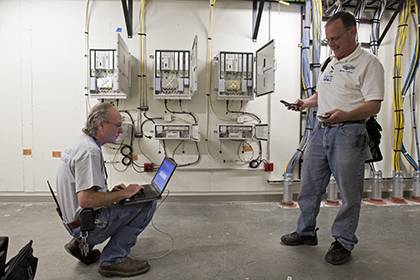Hello, I Can Hear You Better Now
Project to upgrade campus cellular reception in Duke buildings is half complete

Work to upgrade cellular networks at Duke is half complete with more than 6.5 million square feet – the equivalent of about 113 football fields – now receiving better signals.
Duke’s Office of Information Technology (OIT) has coordinated the upgrade for more than 80 Duke buildings; an additional 6.5 million square feet are scheduled to receive cell signal enhancements this spring.
Cellular providers, Verizon, AT&T and Sprint are funding the $25 million upgrade through an agreement with OIT, the first of its kind between a large university and cell providers, according to OIT. The providers will also fund any future upgrades over the next 22 years at no direct cost to Duke.
“It is unprecedented,” said John Andreala, OIT assistant director of communication infrastructure. “The providers realized the value of serving the Duke community and they really stepped up to make this happen.”
The upgrade is necessary because students, faculty and staff increasingly rely on cellular service for work and personal communication needs. Also, the DukeALERT emergency notification system is reliant on robust voice and data services throughout Duke buildings.
The Distributed Antenna System project began on University and Health System campus buildings in September 2013. At times during the project, six construction crews were on campus, installing devices and laying fiber as part of the upgrade.
This spring, Duke Regional and Duke Raleigh hospitals are scheduled for the upgrade, as well as Smith Warehouse, Wallace Wade Stadium and other buildings.
Andreala said that users in upgraded buildings “can expect to see improved service in both call quality as well as phone web surfing, with download speeds as high as 60 migabits per second, which is equivalent to high-speed internet service.”
John Robinson, assistant dean of IT at the Nicholas School of the Environment, and his colleagues were excited to move into Duke Environment Hall, the school’s 70,000-square-foot new home, in April 2014. But even new buildings can block a strong cell signal, and a few months after opening, the building received its cell signal upgrade.
“From a business perspective, people are constantly on the move and need to make and receive cell phone calls, especially to our remote sites like the Duke Marine Lab,” Robinson said. “From a personal perspective, people rely on cell phones for sick children, emergencies or other reasons they need to be reached.”
OIT continues to work with building and department representatives to coordinate the remaining sites for upgrading.
Meanwhile, Robinson has words of encouragement for those still waiting for more of their signal bars to light up.
“The upgrade was instantaneous, like flipping a switch,” he said. “One day there was no signal and then the coverage was there, and it’s been reliable since.”